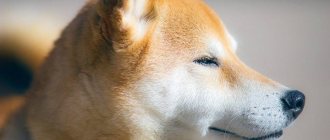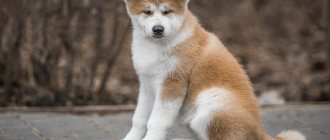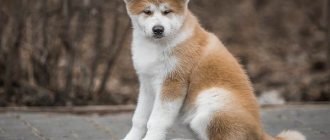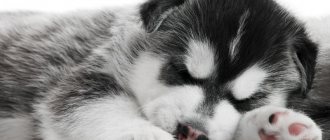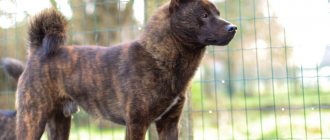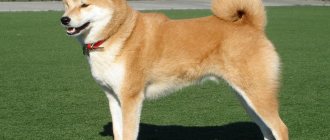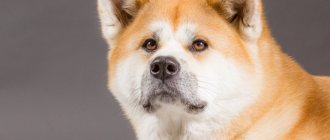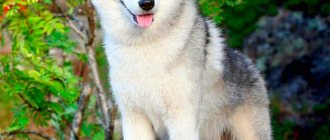May 3039512dog breedwhale
Akita Inu is a Japanese dog breed that originated on the island of Honshu. The Akita Inu breed is the largest Japanese Spitz dog. The Akita Inu dog is a true hunter. For a very long time they were used for hunting deer, wild boars and even bears. The Akita Inu dog breed is a national treasure of Japan. Below you will find a description of the Akita Inu and photos, learn the character of the Akita Inu, and also find useful information about the care and maintenance of the Japanese Akita Inu dog.
General description of the breed
Akita Inu is difficult to classify into any specific category. At different times they were bear hunters, nannies, companions, guard dogs and decorative dogs. This is the largest Spitz breed and one of six on the list of native Japanese breeds protected by the local canine organization. The lifespan of an Akita is from 10 to 14 years.
Photo: klkfavorit.ru
Japanese variety
The Japanese Akita Inu dog is also called triangular because of the unusual shape of its head. She is also given away by her small eyes and slightly upturned nose.
The Japanese Akita, in turn, is divided into two subspecies: red and brindle.
The red subspecies has a uniform red color with light areas in the lower part of the body. But the tiger is replete with different colors: black, red or even blue.
Origin story
In Japan, Akita Inus were bred as guard and hunting dogs. According to research, this is one of the oldest breeds in the world, with traces of its ancestors dating back to the 2nd millennium BC. Even ancient drawings with very similar dogs have been preserved.
Already in the 6th century there were clubs for Akita Inu lovers who were engaged in breeding and training dogs. And later general stud books appeared. At the beginning of the 17th century, Akitas were used in dog fighting, and in the 19th they began to be actively crossed with other larger breeds.
In wartime, Akita Inu were more popular than shepherd dogs, and it was after World War II that, after all the crossbreeding, several subspecies were finally identified. Even later, their own version of the breed was brought to the USA by crossing with the same shepherd dogs and mastiffs.
Photo: funart.pro
American variety
The main difference from its Japanese relative is stockiness and power. In Russia, this particular variety of Akita Inu is most common. They are more courageous and ready to protect not only the owner’s property, but also himself.
Interesting fact: Japanese and American litters can produce long-haired puppies. This is not the standard of this breed, but simply its feature. On average, every fourth Akita Inu puppy has long hair.
Akita Inu: breed standard
For all its plushness, the Akita Inu is a fairly large dog. She will grow up to 50 kg and 70 cm at the withers, with a charming red, brindle or white coloration. American Akitas are allowed a black mask, but Japanese Akitas are not.
The hard and straight coat seems to consist of three layers. It is its structure that determines the charming appearance of the dog. There is a subspecies of long-haired Akita Inu that can unexpectedly appear even in the litter of “standard” parents. This is a genetic trait.
The dog has harmonious and correct proportions, a strong build and a moderately long muzzle without sharp features. It has a large black nose and small eyes with slightly raised corners. The dense triangular ears are erect and close set.
The Akita Inu has a muscular neck, a developed chest and the same lower back. The tall, thick tail is curled into a ring, and the paws are thick and rounded. The Akita moves very smoothly and softly, but the gait is strong and confident.
Photo: zverushki.media
Pit bull (American pit bull terrier): description of the breed, character and care
Ginger
Dogs with red hair are distinguished by their photogenicity and striking appearance. Dogs with a similar color necessarily have white areas on the chest, paws, and muzzle. Individuals with snow-white spots in the neck area are allowed to mate, but the presence of wide spots will be considered a disadvantage.
Photo from Instagram account akita.salzburg
The main sign of the colorfulness of the coat is the blackness of the baby of the above breed. Until the age of three months, the dark color of the Akita Inu disappears, and the little creature acquires a rich red coat. The darker the baby's coat color at birth, the richer his coat will become in adulthood.
Small red Akita Inu representatives in childhood do not look like their parents. If a purebred dog was born with a gray undercoat and a dark muzzle, then there is no need to worry, since the color will soon fade and become red.
The appearance of the modern Akita Inu has constantly changed; it was significantly influenced by the time and living conditions of representatives of this breed. The same features affected the quality of the animal’s fur, and breeders for a long time tried to revive the original appearance of the representatives of the breed, since the price and prestige of the puppy depended on this. Judging by the huge number of colors, geneticists were able to develop a unique breed of dog.
Akita Inu character
The Akita Inu has a truly oriental character and temperament. This must be taken into account when you decide to get such an exotic breed.
Traits and Temperament
Akitas are very balanced, not at all aggressive and calm in any situation. At the same time, they are curious and playful - such a funny combination of contradictions.
Photo: doctorpets.ru
Attitude towards the owner
There is no need to even create legends about the devotion of the Akita Inu - this is a long-confirmed fact. But such a dog is not suitable for beginners, and standard methods of building relationships and education do not work with it. She does not need a master in the literal sense of the word - she needs an equal friend.
Photo: vetbober.ru
Attitude towards children
Akita loves children, willingly plays with them and can look after the baby. But the dog does not tolerate bad treatment and will avoid situations in which it is too uncomfortable.
Photo: vplate.ru
Relationships with other animals
Akita Inu is quite friendly and phlegmatic towards other animals. But to ensure that there are no conflicts, the puppy must be socialized from the first months.
Photo: dogzy.ru
How to choose your future pet?
Before such an important step as purchasing a puppy, you should follow these recommendations:
- Before purchasing a dog, study the breed standards, appearance and physical shape;
- a Japanese breed dog definitely requires a certain metric, make sure it is there;
- when purchasing, pay attention to the puppy’s mother, she should be calm, balanced, and not show signs of aggression or pain;
- if you decide to purchase an older puppy (from 4 months), make sure that he is socialized and is in close contact with the breeders and his brothers;
- try to purchase a puppy of this breed only in a special nursery from experienced breeders;
- If possible, find out whether the puppy’s parents had hereditary diseases, what chronic diseases they suffer from;
- check with the breeder what the puppy eats and how to continue feeding it at home;
- find out as much as possible about the character of the future pet, some breeders are willing to share this information;
- pay attention to the features necessary to belong to the standard - dark nose, coat color red, brindle, white with spots, thick coat with undercoat, triangular eyes, slightly elongated muzzle, high-set tail, plump ears of small size slightly pointed downwards.
IMPORTANT!
If you are planning a show career for your pet, you should not take a long-haired Akita Inu. Long pieces are considered a deviation from the standard and are not allowed for exhibitions.
Akita Inu care
Although Akita Inu are very different from the breeds we are used to, they do not have many specific subtleties in care. We found out everything!
Conditions of detention
Akita Inu can live in an ordinary apartment and will grow up to be a real city dweller. They also really like being in nature, but you can’t leave the dog outside on a leash - it needs a home.
Photo: veterinargid.ru
Hygiene
To keep the Akita's coat beautiful and neat, it should not be bathed often - a maximum of 2 times a year. And we need special hypoallergenic shampoos and products. But you will have to comb the beauty every day, with two brushes - for the coat and the undercoat.
Teeth are brushed every few days, and nails are trimmed every 2 weeks. You also need to examine your eyes and ears for abnormalities. Accustom your Akita to cosmetic procedures from childhood - and she will endure them patiently.
Photo: vkbase.ru
Walks
In order for an Akita Inu to grow up healthy and happy, it needs to spend at least two hours a day outside. They love different places, outdoor games and physical activity, and also choose their own routes and walk without a harness. Please note that you cannot walk your Akita immediately after eating, so it is better to feed the dog after the walk.
Photo: funart.pro
Education and training
Akitas are very smart, but also very stubborn, making them difficult to train. This is not a dog that will fetch a ball or slippers every time. She demands respect for herself, and only then gives it in return. Be patient, persistent and persistent!
Photo: dastereo.ru
Scottish Fold cats: description, character and care
Distinctive features
- General appearance : large in size, well balanced; sexual dimorphism is pronounced. This dog has an aristocratic appearance, is very affectionate, and has a sense of self-esteem.
- Important proportions: the height at the withers to the length of the body (measured from the shoulder-scapular joints to the ischial tuberosities) is 10:11; bitches have a slightly longer body.
- Personality: Loyal, obedient and friendly.
- Head: wide forehead with a groove in the middle. Stop pronounced. The nose is large and black. The muzzle is of short length with a wide base, which tapers slightly towards the nose. The nose is straight. Strong teeth, scissor bite. Lips tightly fitting, developed cheekbones, not very large eyes of a dark brown color with raised outer corners, forming an almost “triangular” shape. The ears are not particularly large, triangular in shape, with slightly rounded tips, not particularly wide apart, erect and tilted slightly forward.
- Neck: Muscular, without dewlap, in proportion to the head.
- Body: straight and strong back with a wide loin. The chest is deep with a developed forepart. Well toned stomach. The tail is set high and curls, and when lowered it reaches the hocks.
- Forelegs: Medium inclined and developed shoulder blades. The elbows are pressed tightly to the body. Straight forearms with strong bones.
- Hind limbs: well developed, fairly strong, with medium angulations.
- Paws: powerful, rounded, stable.
- Dimensions: height at withers: males: 67 cm, females: 61 cm. Deviations from the above dimensions are allowed no more than 3 cm in any direction.
What to feed your Akita Inu
Remember that the Akita Inu is a Japanese breed, so fish and rice will be appropriate in its diet. And also barley, potatoes and light vegetables. But there are often allergies to the usual poultry and beef, and in general, feeding the Akita is different. For example, they cannot eat a lot of protein foods, including any meat.
But boiled meat in combination with fermented milk products is beneficial for the development of puppies. You can give eggs and sometimes apples, but offal, pork and flour products are prohibited. The puppy is fed 4-5 times a day, and you can switch to an adult regimen with 2 meals a day at 8-10 months.
With adult Akita Inu everything is simpler. On average, meat and fish, cereals, vegetables and dairy products should be in approximately equal proportions. You cannot give sausages, smoked meats, spices, pickles, river fish with small bones, raw meat and sugar in any form. Dry food also needs specialized food, for exotic breeds and without wheat and corn.
Photo: littlepets.ru
Key points in training
When training, it is worth remembering that the dog has a strong and independent character, so training should begin as early as possible, while showing calm and perseverance.
- The dog responds to aggression with aggression, so under no circumstances should you raise your voice, hit the Akita, or look directly into the eyes. You need to talk to your pet in a calm tone.
- Food rewards do not work on representatives of this breed; you need to look for an individual approach to your pet.
- Akita will not tolerate monotonous and boring training - it is better to present training in the form of a game.
- You should not force your dog to engage in physical activity if it is tired or uninterested.
- You should not allow the dog to jump on a person, butt heads or demand attention - otherwise the Akita will stop obeying.
If you do not have confidence in your own abilities, it is better to entrust the dog to a professional trainer.
Read about how to properly train a dog in the article: “Training a puppy: effective methods from dog handlers, learning commands at home.”
Health and disease of the breed
Akitas are notable for their excellent health and very rarely get sick. But they are prone to allergies, so you need to carefully monitor their diet. Joint problems, hypothyroidism, eye diseases and bloating are rare. The most dangerous problem that requires immediate intervention is gastric volvulus.
Photo: nekusaka.com
Pomeranian Spitz: breed description and care (60 photos)
Akita Inu - photo
Look how beautiful Akita Inu dogs are at any age! Well, how can we resist here?
Photo: akitainu.kz
Photo: youtube.com
Photo: dogcatdog.ru
Photo: dogsta.ru
Photo: animaljournal.ru
Photo: goldperepel.ru
Photo: abrikos1.ru
Photo: kakprosto.ru
Photo: hola.com
Photo: klkfavorit.ru
Photo: wallpaperscraft.ru
Photo: pet7.ru
Photo: funart.pro
Photo: klkfavorit.ru
Photo: domashniydrug.ru
Photo: mnogo-krolikov.ru
Photo: goodfon.ru
Photo: doggav.ru
Photo: decordog.ru
Photo: sobaki.pro
Photo: wallpaper.mob.org
Photo: dogzy.ru
Photo: izi.ua
Photo: smallivingworld.ru
Photo: vk.com
Photo: youtube.com
Did you like the post? Subscribe to our channel in Yandex.Zen, it really helps us in our development!
